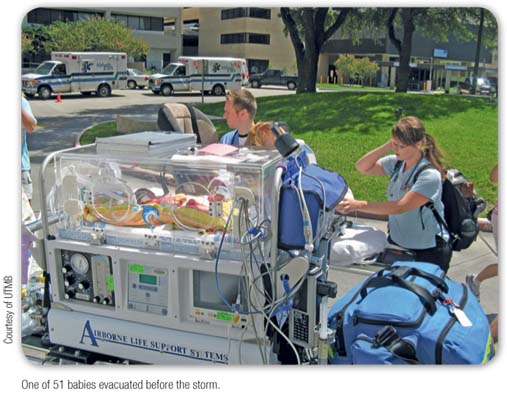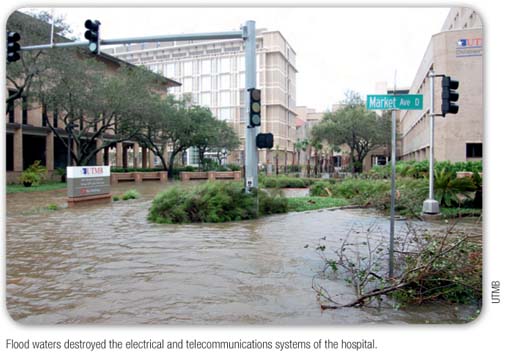NEWS
Hospital safety: Texas dodged a bullet
One year after hurricane Ike hit the coast of Texas in the United States of America, the evacuation of John Sealy Hospital in Galveston is held up as an example of how to ensure patient safety during a crisis: one that almost shut down the entire state's hospital system. Katherine Adams reports.
Hurricane Ike was just one disaster among many in 2008, a year in which 235 816 people died in such events - Cyclone Nargis in Myanmar and the Sichuan earthquake in south-western China being the most notable. Hospital safety has been under the spotlight this year with the World Disaster Reduction Campaign, World Health Day and the International Day for Disaster Reduction on 14 October 2009 all highlighting the importance of safe hospitals during disasters. While high winds and earthquakes tend to grab the headlines, it is flooding that most frequently devastates, as has been demonstrated by the recent typhoon in the Philippines. It was flood water that wrecked the John Sealy Hospital.
Wedged in among the buildings of the University of Texas Medical Branch (UTMB) on Galveston Island, the twelve-storey hospital was hit by a wall of water driven across the island by winds of up to 180 kilometres per hour in the early hours of 13 September 2008. Gushing in through doors and windows, it inundated the basement and ground floor, destroying the blood bank, sterile processing laboratory and pharmacy and taking out the electrical and ventilation systems, along with phone lines, computer systems and elevators.

Surprisingly nobody was injured. Credit for this goes in part to local authorities for issuing a mandatory evacuation order in time for a pre-agreed evacuation plan to be carried out. Hospital and city employees shut down the entire UMTB campus, secured laboratories and made arrangements to send around 400 patients, including 51 newborns from the neonatal unit and 14 organ transplant patients, by ambulance or helicopter to waiting hospitals further inland.
Dr Luca Cicalese, director of the Texas Transplant Center at John Sealy, headed up a team responsible for getting the organ transplant patients out, some of whom were still in intensive care as the storm closed in. "We had just a few hours to complete the evacuation," says Cicalese. "Patients were out by Thursday and the storm made landfall Friday [night]." Despite the time pressure, there was no panic or confusion because of what Cicalese terms, "excellent leadership, communication and coordination". His wife, Dr Cristiana Rastellini, director of Cell Transplant and Transplant Research at John Sealy, cites orderliness and speed as having been crucial for saving transplant patients, who were hooked up to "every kind of machine". She also stresses the importance of forward planning for saving her laboratories.
One reason UTMB survived the storm so well is that it had been through it all before. Back in 2005, hurricane Rita passed close enough to the island to trigger Galveston's evacuation plan, an event that Mike Megna, one of two Institutional Emergency Preparedness officers at UTMB, says taught staff and administrators several important lessons. "We have reassessed our vulnerability to flooding and consequently [since Ike] have not returned any mission-critical functions to first floor [ground floor] space," says Megna. He also stresses the importance of having an adaptable game plan, and making sure personnel are not just mentally but also physically prepared for post-hurricane conditions, including the challenge posed by the shut-down of elevators, air-conditioning and water supply. Running up and down a twelve-storey building in 40 °C heat is not for the faint-of-heart or the out-of-shape.
Preparing staff for water loss in a flooded hospital may seem odd on the face of it, but it goes to the heart of one of the biggest challenges faced by hospitals in crisis situations triggered by natural disasters. Simply put, there is a limit to what an individual hospital can achieve without support from surrounding hospitals and emergency services, but even that support can be compromised in natural disasters, which tend to have a regional rather than local impact on the utilities that run the hospitals.
Scott Lillibridge, professor of epidemiology at Texas A&M University, located 70 kilometres north of Galveston, saw precisely how close the hospitals of the Houston region, which includes Galveston, came to collapsing as a result of broad systemic failure. Lillibridge's office was mobilized by the state health department to help during the storm, and participated in the initial hospital assessments of the region which revealed that 20 out of 170 hospitals over an area greater than 320 square kilometres had been badly damaged, with 17 requiring evacuation.
For Lillibridge, the main source of concern was the Texas Medical Center, a collection of more than 45 hospitals and institutions located in Houston, employing more than 90 000 health-care workers. While Houston did not take the brunt of the storm the way Galveston did, Ike did knock out the city's water pumping systems, and that was sufficient to threaten the whole health-care system. In the words of Lillibridge: "The lack of water pressure to hospitals in Houston during the immediate post-disaster period almost resulted in one of the largest patient evacuations in history."

There was no wall of water, no howling winds; just the sound of taps drying up and toilets ceasing to flush. "Without water for toilets, laundry and food service the hospitals were down to their last 24 hours of patient services before throwing in the towel," Lillibridge says. As bad as this was, worse was threatened. According to Lillibridge, there was not enough bed capacity in the entire state to receive patients from Texas Medical Center. Says Lillibridge: "[The hospitals] absolutely could not have gone [on] one more day."
And it wasn't just the water that almost dried up in Texas. Because there were no more patients at UTMB, there was also no more income. This sudden loss of its revenue stream, along with US$ 125 million in unpaid patient bills, was enough to send it into a financial tailspin and prompted a highly controversial staff reduction of more than 2500 employees, including professors, doctors and researchers. In the 12 months following the hurricane, the hospital has struggled back to financial health, with a US$ 150 million contribution from the state government and US$ 450 million from the Federal Emergency Management Agency. "The total repair estimated for the campus is over US$ 667 million," says Michael Shriner, vice-president of Business Operations and Facilities at UTMB. "We were not operating in the black before the storm because so many of our patients were indigent. Before we invest over US$ 600 million in repairs, we have to evaluate choices about what comes back and how it can be brought back in a more durable and sustainable way."
"Durable" and "sustainable"; the words are at the forefront of the current debate on health-care reform in the USA. It remains to be seen whether they inform the bill President Barack Obama is eventually handed to sign. In the meantime, Texas has shown that it knows how to plan for future natural disasters and that it is capable of carrying out its rescue and relief operation for its hospital system.
Find out more about what international organizations are doing to make hospitals safe from disasters at: http://www.safehospitals.info/ 
